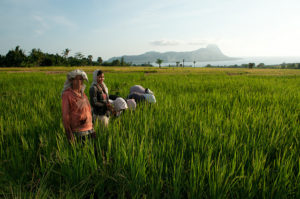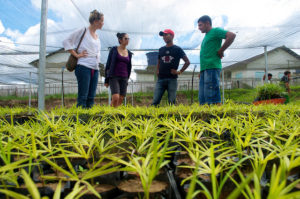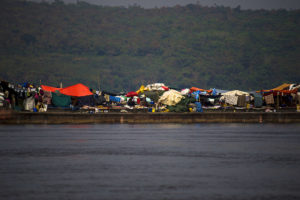
By Vincent Gitz, Director of the CGIAR Research Program on Forests, Trees and Agroforestry
I am glad to close this initial series of blogs (Flagship tree genetic resources, livelihood systems, value chains, landscapes, climate change, Gender, MELIA) by FTA scientists and partners (Tropenbos International, INBAR) that herald phase 2 of FTA research and this year’s work. It shows how incredibly rich and wide-ranging FTA is as a program!
Shared goals and joined-up work
The FTA management team has just gathered to agree on the research and development priorities for 2017. Researchers will work toward our objectives for 2022, but also have three overarching world goals in line of sight:
- Reaching the Sustainable Development Goals (SDGs), with food security and nutrition instrumental among them;
- Addressing climate change adaptation and mitigation;
- Addressing landscape challenges to achieve sustainable land use at various levels.
As shown by the Global Landscapes Forum 2016, these goals are interlinked at global and local levels, and none of them can be reached without forests, trees and agroforestry. FTA systems, as we call them, are crucial for the planet, critical for many countries – for economic, social, environmental reasons – and essential for the many households that depend on them for their livelihoods and food security.
FTA at the beginning of FTA phase 2 is well equipped for joined-up work across scales, toward effective implementation and impact.

Making FTA a reference global partnership for impact
FTA organizes its research priorities to maximize the contribution of forests, trees and agroforestry to the overarching challenges described above. We will strive to make FTA a tool for impact, precisely we could call it “FTA for food security and sustainable development”.
Our objective here is to build a case, by making FTA’s work, results and intentions even better known in the development arena.
My vision for FTA is for all partners to work together to make it the reference global partnership for science and research in development on forests, trees and agroforestry – and landscapes – to achieve on the ground impact for food security and sustainable development.
Enabling shared understanding on difficult issues
The domain in which we operate is full of hot topics: deforestation, biodiversity erosion in our ecosystems and in agriculture, forest plantations, biofuels, large-scale versus small-scale agriculture, migration, sustainable consumption patterns, fair trade, responsible value chains, finance and investments, technological orientation of agriculture, intellectual property rights.
These are all issues one can look at from many perspectives and for which disagreement often hinders sound decision making. In FTA, we recognize that, to make progress for sustainable development outcomes, we need to recognize differences and controversies and provide evidence to address them.

Our partnership strives to provide the knowledge to underpin a shared understanding on why stakeholders might disagree on difficult issues, and to propose options suitable to different contexts.
So, in phase 2, FTA will aim to organize exchanges and dialogues between disciplinary perspectives and national perspectives, thus giving policy makers, practitioners, companies and farmers the means to better take into account all dimensions of sustainable development.
One very good example of this approach, is the gender work in FTA. In phase 1, FTA has shown that
- there are a range of existing gender inequalities, from access to resources and services, participation in decision making, to benefit sharing,
- policies and interventions have gender differentiated impacts,
- issues of migration, of multi-local households, lead to gender/youth inequality.
In phase 2, FTA research will aim at assessing root causes and mechanisms that lead to such situations. We will provide and make available firstly, more information and data in what remains a globally under-researched area, and, secondly, policy guidance in forestry and agroforestry and connected domains to achieve equity and inclusion.
To do so, participatory action research is a tool for impact in itself.
From place-based research to international public goods
Phase 2 of FTA starts in a challenging institutional environment, but with reinforced partnerships. Tropenbos International and the International Bamboo and Rattan Organisation (INBAR) have joined the set of FTA strategic partners (World Agroforestry Centre, Bioversity International, CATIE, CIRAD, and CIFOR as lead center). With multiple partnerships operating in very diverse environments, FTA is going to hold very strongly its focus on research that produces global international public goods.
FTA research has its feet on the ground and is always place-based. But one of the key innovations is to build cross-cutting research protocols to ensure that any place-based research occurring in FTA is contextualized and can be linked to a series of extrapolation domains, enabling FTA research to be relevant across a wider range of contexts than just the places where it is conducted. In 2017, this will be a key aspect of the work on Sentinel Landscapes and on data gathering across the program and with partners.

FTA’s unique comparative advantage: meeting the demand for integrated solution
Growing demand for integrated solutions creates huge opportunities for FTA to make an impact.
- The SDGs serve as operational matrix for the implementation of sustainable development on the ground, within various policies ranging from agriculture, land use, energy and to trade.
- The Paris Agreement and recognition, in the Intended Nationally Determined Contributions (INDCs), of the multiple benefits of action in the land-use and forestry sectors, could not only support adaptation and mitigation, but also generate many other environmental, economic and social co-benefits.
- Food security and sustainable food systems increasingly recognize that FTA issues are central to them. For instance, in 2017, the UN Committee on World Food Security (CFS) will discuss for the first time the issue of forests, and FTA is contributing to the scientific report that will underpin these discussions.
In phase 2, FTA is ready to provide integrated approaches and solutions. I would call it a multiple integration, because simultaneously FTA integrates
- the perspectives of diverse economic sectors and stakeholders on different issues,
- the various roles and complementarities of actors at the landscape scale,
- knowledge across scales for the generation of international public goods
- the generation of knowledge for development outcomes. (With a strategic partnerships it organizes research across the whole spectrum of the theory of change, including on what constitutes the best enabling environment, from institutions to policies and governance, and on the measurement of impacts.)
- the economic, social and environmental dimensions of sustainable development – in the options it proposes.
With all this, FTA is very uniquely placed and stands ready, at the beginning of phase 2, to provide the kind of research that our common vision is calling for.











